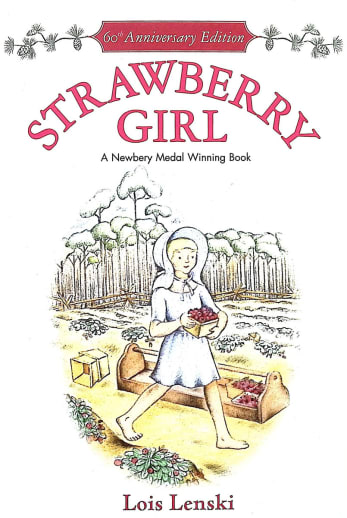It's the early 1900's, and the Boyers have just moved to the Florida backwoods. It's not easy to get their new life of the ground. They have a notion to grow strawberries and sweet potatoes and oranges to sell. The neighbors scoff at their ideas, saying that they can't grow anything in Florida. Birdie Boyer, just ten-years-old, is convinced that they can, if only they could keep everyone else's animals away from their crops! However, this isn't their only problem. The weather is unpredictable with unbearable heat, droughts and cold snaps that threaten their crops. The most worrisome problem is the neighbors next door, the Slaters, who seem to be waiting for any reason to start a feud. The Boyers hold their ground while trying to have a positive impact on the Slaters.
Strawberry Girl
SKU
002480
ISBN
9780064405850
Grade 5-8
These icons are designed to help you quickly understand and learn important information about our products.
Teaching Method
Traditional
Teacher-centered curriculum commonly used in classrooms that may include a text, teacher manual, tests, etc.
Charlotte Mason
A methodology based on the work of a 19th century educator who maintained that children learn best from literature (Living Books), not textbooks.
Classical
A methodology based on the Latin Trivium (three stages of learning), including the grammar stage (memorization and facts), logic stage (critical thinking), and rhetoric stage (developing/defending ideas).
Unit Study
A thematic or topical approach centered around one topic that integrates multiple subject areas.
Montessori (Discovery)
A methodology based on the work of a 20th century educator that emphasizes student and sensory-driven discovery learning and real-life applications.
Other
Other methodologies
Religious Content
Secular
Contains content contrary to common Christian beliefs (i.e. evolution).
Neutral
Avoids religious or theoretical topics or presents multiple viewpoints without preference.
Christian/Religious
Faith-based or including instructional religious content.
Learning Modality
Auditory
Learns through listening, talking out loud or reading out loud.
Visual
Learns through seeing, prefers written instructions and visual materials.
Kinesthetic/Tactile (Hands-On)
Learns through moving, doing and touching.
Multi-Sensory
Curriculum that employ a variety of activities/components.
Presentation
Sequential
Curriculum progresses through well-defined learning objectives. Emphasizes mastery before moving to the next topic.
Spiral
Topics and concepts are repeated from level to level, adding more depth at each pass and connecting with review.
Conceptual/Topical
Focus is on the “why,” often with a unifying concept as well as specific skills; coverage may be broader.
Teacher Involvement
Low Teacher Involvement
Student-led materials; parent acts as a facilitator.
Medium Teacher Involvement
A mix of teacher-led time and independent student work.
High Teacher Involvement
Teacher-led lessons; may utilize discussions, hands-on activities and working together.
Additional Materials Required
No other materials needed
Everything you need is included.
Other Materials Required
There are additional required resources that are a separate purchase.
Other Materials Optional
There are additional resources mentioned or recommended but are not absolutely necessary.
Consumable
Consumable
Designed to be written in; not reusable.
Non-Consumable
Not designed to be written in; reusable.
Our Price
$9.99 $9.99 $7.95
Rainbow Savings: $2.04
Description
Publisher's Description of Strawberry Girl
Rediscover this Newbery Medal–winning classic, a favorite of generations.
Strawberries—big, ripe, and juicy. Ten-year-old Birdie Boyer can hardly wait to start picking them. But her family has just moved to the Florida backwoods, and they haven't even begun their planting. "Don't count your biddies 'fore they're hatched, gal young un!" her father tells her.
Making the new farm prosper is not easy. There is heat to suffer through, and droughts, and cold snaps. And, perhaps most worrisome of all for the Boyers, there are rowdy neighbors, just itching to start a feud. The land was theirs, but so were its hardships.
Details
| Product Format: | Softcover Book |
|---|---|
| Grades: | 5-8 |
| Brand: | HarperCollins |
| Author: | Lois Lenski |
| ISBN: | 9780064405850 |
| Length in Inches: | 5.13 |
| Width in Inches: | 7.63 |
| Height in Inches: | 0.62 |
| Weight in Pounds: | 0.0197 |
| Ages: | 10+ |
| Edition: | 60th Anniversary Edition; Special; Illustrated |
| Illustrated by: | Lois Lenski |
| Pages: | 208 |
Videos
Reviews

